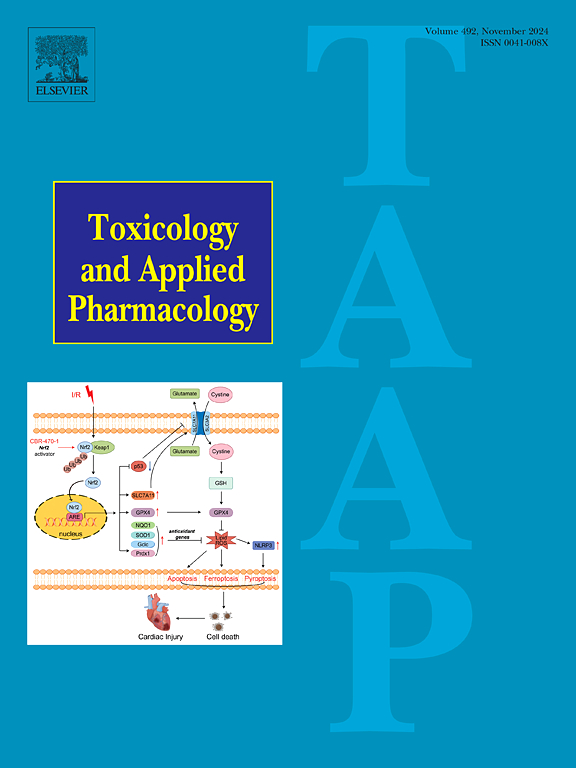新型NLRP3抑制剂通过抑制肺泡上皮细胞焦亡来减轻急性辐射诱导的肺损伤
IF 3.3
3区 医学
Q2 PHARMACOLOGY & PHARMACY
引用次数: 0
摘要
目的放射诱导肺损伤(RILI)是由nlrp3介导的放射引发的焦亡引起的,是胸部肿瘤放疗的严重并发症。本研究旨在设计针对肺泡上皮细胞焦亡的新型NLRP3抑制剂,以减轻RILI并阐明其潜在机制。方法合成靶向NLRP3 NACHT结构域的squinoxalinone衍生物QK-3A - QK-3E。在辐照A549和MLE-12细胞中,采用高含量筛选方法评估其对NLRP3/GSDMD通路和细胞因子(IL-1β, IL-18)的影响。C57BL/6小鼠RILI模型通过HE染色、Western blot、免疫荧光等方法评价复方药效。评估了安全性。结果单细胞测序数据集分析显示,在早期RILI期间,肺泡2型(AT2)细胞比例显著降低(从12.41%降至4.02%),AT2细胞中与热作用相关的基因活性增强。分子对接表明,QK-3E与NLRP3残基ARG351和PHE575强结合,抑制其活化。在体外,QK-3D和QK-3E降低辐射诱导的裂解caspase-1/GSDMD-N表达(约30% - 75%)和IL-1β/IL-18释放(约30% - 50%),抑制AT2焦亡。在体内,QK-3D和QK-3E降低了肺指数升高(约25%),减轻了肺部和全身炎症,并且优于地塞米松。他们下调SPC+ AT2细胞中的GSDMD-N(约20% - 30%)和切割-caspase-1(约50% - 60%),阻断焦亡,无心脏毒性、肝毒性或肾毒性。结论NLRP3抑制剂QK-3D和QK-3E通过抑制NLRP3/GSDMD通路抑制AT2焦亡,有效缓解RILI,为早期干预提供了一种有效、安全的治疗候选药物。本研究提出了针对炎症性疾病的焦热靶向策略。本文章由计算机程序翻译,如有差异,请以英文原文为准。

Novel NLRP3 inhibitors mitigate acute radiation-induced lung injury by suppressing pyroptosis in alveolar epithelial cells
Objective
Radiation-induced lung injury (RILI), a severe complication of thoracic tumor radiotherapy, is driven by NLRP3-mediated pyroptosis triggered by irradiation. This study aimed to design novel NLRP3 inhibitors targeting pyroptosis in alveolar epithelial cells to alleviate RILI and elucidate underlying mechanisms.
Methods
Quinoxalinone derivatives (QK-3A – QK-3E) targeting the NACHT domain of NLRP3 were synthesized. Their effects on the NLRP3/GSDMD pathway and cytokines (IL-1β, IL-18) were evaluated in irradiated A549 and MLE-12 cells using high-content Screening. A C57BL/6 mouse RILI model assessed compound efficacy via HE staining, Western blot, immunofluorescence. Safety was evaluated.
Results
Single-cell sequencing datasets analysis revealed a marked reduction in alveolar type 2 (AT2) cell proportion (from 12.41 % to 4.02 %) during early RILI, with pyroptosis-related genes showing heightened activity in AT2 cells. Molecular docking demonstrated QK-3E's strong binding to NLRP3 residues ARG351 and PHE575, inhibiting its activation. In vitro, QK-3D and QK-3E reduced radiation-induced cleaved-caspase-1/GSDMD-N expression(about 30 %–75 %), and IL-1β/IL-18 releases(about 30 %–50 %), suppressing AT2 pyroptosis. In vivo, QK-3D and QK-3E attenuated lung index elevation(about 25 %), mitigated pulmonary and systemic inflammation, and outperformed dexamethasone. They downregulated GSDMD-N(about 20 %-30) and cleaved-caspase-1(about 50 %–60 %) in SPC+ AT2 cells, blocking pyroptosis without cardiotoxicity, hepatotoxicity, or nephrotoxicity.
Conclusion
The NLRP3 inhibitors QK-3D and QK-3E effectively alleviate RILI by suppressing AT2 pyroptosis via NLRP3/GSDMD pathway inhibition, offering a potent and safe therapeutic candidate for early intervention. This study advances pyroptosis-targeted strategies for inflammatory diseases.
求助全文
通过发布文献求助,成功后即可免费获取论文全文。
去求助
来源期刊
CiteScore
6.80
自引率
2.60%
发文量
309
审稿时长
32 days
期刊介绍:
Toxicology and Applied Pharmacology publishes original scientific research of relevance to animals or humans pertaining to the action of chemicals, drugs, or chemically-defined natural products.
Regular articles address mechanistic approaches to physiological, pharmacologic, biochemical, cellular, or molecular understanding of toxicologic/pathologic lesions and to methods used to describe these responses. Safety Science articles address outstanding state-of-the-art preclinical and human translational characterization of drug and chemical safety employing cutting-edge science. Highly significant Regulatory Safety Science articles will also be considered in this category. Papers concerned with alternatives to the use of experimental animals are encouraged.
Short articles report on high impact studies of broad interest to readers of TAAP that would benefit from rapid publication. These articles should contain no more than a combined total of four figures and tables. Authors should include in their cover letter the justification for consideration of their manuscript as a short article.

 求助内容:
求助内容: 应助结果提醒方式:
应助结果提醒方式:


